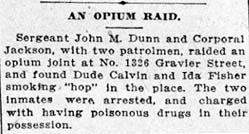- International Opium Convention
Infobox Treaty
name = International Opium Convention
long_name =

image_width = 249px
caption = Opium article from The Daily Picayune, February 24, 1912, New Orleans, Louisiana
type =
date_drafted =
date_signed =January 23 ,1912
location_signed =The Hague
date_sealed =
date_effective =February 11 ,1915 /June 28 ,1919
condition_effective =
date_expiration =
signatories =
parties =
depositor =
language =
languages =
website =
wikisource =The International Opium Convention, signed atThe Hague onJanuary 23 ,1912 , was the first international drug control treaty. The United States convened a 13-nation conference of theInternational Opium Commission in 1909 inShanghai, China in response to increasing criticism of theopium trade. The treaty was signed byGermany , theUnited States ,China ,France , theUnited Kingdom ,Italy ,Japan ,The Netherlands , Persia,Portugal ,Russia , andSiam . The Convention provided that "The contracting Powers shall use their best endeavours to control, or to cause to be controlled, all persons manufacturing, importing, selling, distributing, and exporting morphine, cocaine, and their respective salts, as well as the buildings in which these persons carry such an industry or trade."The Convention was implemented in 1915 by the
United States ,Netherlands ,China ,Honduras , andNorway . It went into force globally in 1919 when it was incorporated into theTreaty of Versailles .A revised International Opium Convention was signed on
February 19 ,1925 , which went into effect onSeptember 25 ,1928 [ [http://www.findarticles.com/p/articles/mi_m1309/is_2_35/ai_54157834 The beginnings of international drug control] ] . It introduced a statistical control system to be supervised by aPermanent Central Opium Board , a body of theLeague of Nations .Egypt , with support fromChina andUnited States , recommended that a prohibition onhashish be added to the Convention, and a sub-committee proposed the following text:The use of Indian hemp and the preparations derived therefrom may only be authorized for medical and scientific purposes. The raw resin (charas), however, which is extracted from the female tops of the cannabis sativa L, together with the various preparations (hashish, chira, esrar, diamba, etc.) of which it forms the basis, not being at present utilized for medical purposes and only being susceptible of utilisation for harmful purposes, in the same manner as other narcotics, may not be produced, sold, traded in, etc., under any circumstances whatsoever.
India and other countries objected to this language, citing social and religious customs and the prevalence of wild-growing cannabis plants that would make it difficult to enforce. Accordingly, this provision never made it into the final treaty. A compromise [ [http://www.druglibrary.org/schaffer/history/e1920/willoughby.htm W.W. WILLOUGHBY: OPIUM AS AN INTERNATIONAL PROBLEM, BALTIMORE, THE JOHNS HOPKINS PRESS, 1925] ] was made that banned exportation of "Indian hemp" to countries that have prohibited its use, and requiring importing countries to issue certificates approving the importation and stating that the shipment was required "exclusively for medical or scientific purposes." It also required Parties to "exercise an effective control of such a nature as to prevent the illicit international traffic in Indian hemp and especially in the resin." These restrictions still left considerable leeway for countries to allow production, internal trade, and use of cannabis for recreational purposes [ [http://www.unodc.org/unodc/en/bulletin/bulletin_1962-01-01_4_page005.html The cannabis problem: A note on the problem and the history of international action] ] .The Convention was superseded by the 1961
Single Convention on Narcotic Drugs .ee also
*
Legal issues of cannabis References
* [http://www.unodc.org/unodc/en/bulletin/bulletin_1962-01-01_4_page005.html The cannabis problem: A note on the problem and the history of international action] , Bulletin on Narcotics, 1962.
* [http://www.findarticles.com/p/articles/mi_m1309/is_2_35/ai_54157834 The beginnings of international drug control] , UN Chronicle, Summer, 1998.
* [http://www.tc.edu/centers/cifas/drugsandsociety/background/OpiumConvention.html International Opium Convention Signed at The Hague January 23, 1912] .External links
* [http://www.opiummuseum.com/ Opium Museum]
Wikimedia Foundation. 2010.
